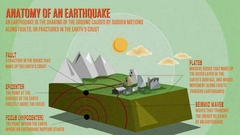![]()
![]()
![]()
Use LEFT and RIGHT arrow keys to navigate between flashcards;
Use UP and DOWN arrow keys to flip the card;
H to show hint;
A reads text to speech;
16 Cards in this Set
- Front
- Back
- 3rd side (hint)
|
Earthquake Definition |
Release of stress that causes geologic faults / volcanic activity |
|
|
|
Types of earthquakes |
Tectonic Volcanic |
2 |
|
|
Fault |
Rocks under pressure causing them to break |
|
|
|
Types of Faults |

Normal Reverse Left-lateral Right-lateral |
|
|
|
Govt Groups |
PHIVOLCS Philippine Institue of Volcanology & Seismology DOST Department of Science & Technology NDRRMC National Disaster Risk Management Council Philippine Red Cross |
|
|
|
Seismic Waves |
1)Primary wave - fastest, tas nagttravel siya in ol types of matter 2)Secondary wave - sa solid lang nagttravel 3)Surface wave- desteuctive 4)Love wave - nakakasira ng bahay |
|
|
|
Parts of an earthquake |

1)Fault- fracture in the rocks that make up the earth's crust 2)Plates- massive rocks that make out rthe outer layer of the earth's surface 3)Seismic waves- waves that transmit the energy released by an earthquake 4)Focus -below epicenter 5)Epicenter - directly above focus • Magnitude - amount of energy released • Intensity- damage |
|
|
|
Instruments |
Mercalli Scale = Intensity Richter Scale = magnitude Rosi-Forrel Scale = Intensity Seismograph = magnitude |
|
|
|
Earthquake Checklist |
B: Be prepared D: Stay Calm A: Be careful |
B S B |
|
|
Foreshock |
Smol b4 major eq |
|
|
|
Aftershock |
Smol after major earthquakes |
|
|
|
Related Hazard |
1)Faulting- creation of new or renewed movements of old fractures 2)Ground shaking- disruptive up and down and sideways vibration of the ground during earthquakes 3)Liquifaction-phenomenon whre the strength or stiffness of the geound is reduced by an earthquake 4)Tsunami 5)Fire 6)Landslides-downslope movement of rocks |
|
|
|
Triangulation |
Geologists identify where an earthquake started |
|
|
|
Effects of Related Hazard |
1) Burial 2) Erosion 3) Blockage |
|
|
|
Deadliest earthquake |
1556 in central chine |
|
|
|
Largest earthquake |
9.5 Chile |
|

